Post by aerofoto - HJG Admin on Apr 23, 2007 6:27:43 GMT
Without a doubt the B707 is by far best known of all first generation 4 engined narrow-body civil jetliners. Originating from a USAF requirement for jet powered aerial refuellers during the mid 1950's, this aircraft evolved through several turbojet and fanjet powered models of varying structural configurations and performance capabilities, to ultimately transform the Boeing company from obscurity to the forefront of modern jetliner production and become one of the worlds most successful civil aircraft.
B367-80 (otherwise known as DASH 80) is the aircraft which spawned the B707 legend. Intended as a jet tanker/transporter demonstrator, work on this new design began during 1952 under a preliminary 707-6 title and publicly announced as B367-80 during September 1952. This designation was intended to misslead Boeing's competitors into believing the new aircraft was little more than another military project and a jet powered successor to Boeing's piston engined KC97 tanker then in service with the USAF rather than a prospective commercial transport. Fully funded by Boeing to the tune of some $16 milion (1952) dollars, it was hoped this expenditure would be reclaimed through Independant Research & Development funding followed by long term production of both military and civil contracts. It was also anticipated construction of both variants would utilize the same tooling but through market pressure, and progressive design enhancement, 2 distinctly different families of aircraft emerged with little in common with each other despite visually similar external silhouettes. B367-80 was completed some 2 weeks ahead of schedule and rolled-out at Boeing/Renton on March 14 l954 christianed "Jet Stratoliner". On July 15 1954 the new aircraft performed its maiden flight and the B707 legend was born.
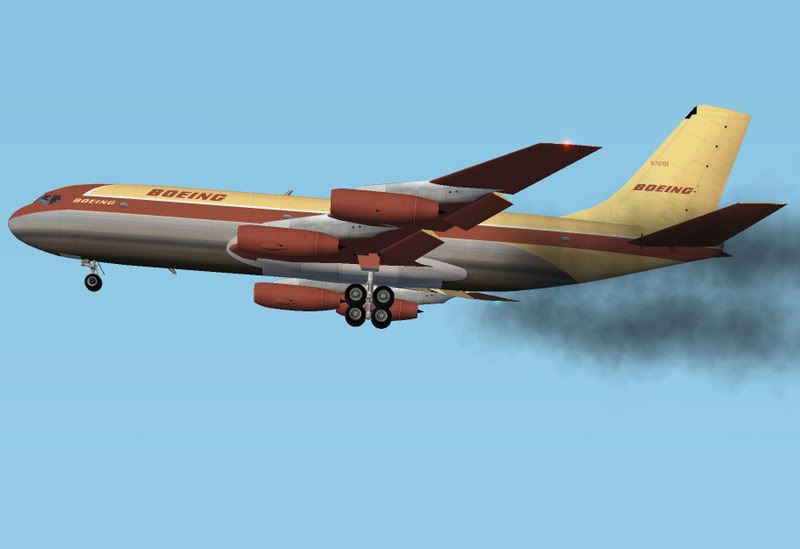
B367-80 had a fuselage length of 127ft 10in with a cross-section diameter of 132in, and a wingspan of 130ft. At the time of its first flight the aircraft was powered by 4 P&W JT3P turbojet engines (with water methanol injection system) rated at 9,500-11,000lb/st e/a and not equipped with thrust reversers. The aircraft had a MTOW of 190,000lb, and payload range of some 2,600nm.
Throughout its long service career B367-80 was used extensively by Boeing for both demonstration and development work in support of C135, B707, B727, and other aircraft programes, scientific research in conjunction with NASA, and systems analysis in association with the Seattle Flight Test Center. These projects saw the aircraft constantly modified over the years with various combinations of powerplants, alterations to both wing and flap systems, experimental landing gear, and various other projections. By 1971 B367-80 had outlived its usefulness as a research/development platform and was withdrawn from service. It was donated to the National Air & Space Museum/Smithsonian Institution on November 26 1972 and stored at Davis-Monthan AFB Arizona for some 18 years. Resurrected from the desert on May 7 1990, B367-80 was returned to its Seattle birthplace for refurbishment and display at the Boeing Museum of Flight as one of the single most important aircraft of the jet age.
Early B367-80 demostration flights soon convinced the USAF of the new aircrafts potential. This resulted in a huge military contract for production of an aircraft Boeing termed B717 but which was redesignated C135 (type) on the USAF inventory. The first military production aircraft was a KC135-A named "City of Renton". This aircraft was rolled-out at Boeing/Renton on July 18 1956 and first flew on August 31 1956. It was delivered to USAF/SAC at Castle AFB California on June 28 1957. Production of USAF C135 aircraft amassed to some 820 airframes over a wide range of derivatives fulfilling numerous specialist air roles across a multitude of military/government service descriptions.

KC135-A aircraft had a fuselage length of 136ft 2in with a cross-section diameter of 144in, wingspan of 130ft 10in, and were powered by 4 P&W J57-P-59W turbojet engines (with water methanol injection system) rated at 11,200-13,000lb/st e/a and not equipped with thrust reversers. These aircraft had a MTOW of up to 300,000lbs (overload) though typically this was reduced to 112,400-261,000lbs, and range of some 1,880nm depending upon payload and reserves. Despite their logistic/strategic versatility KC135-A aircraft were among the most noisy, dirty, and airfield demanding aircraft on the USAF inventory requiring no less than 10,000-13,700ft of runway depending upon load circumstances.
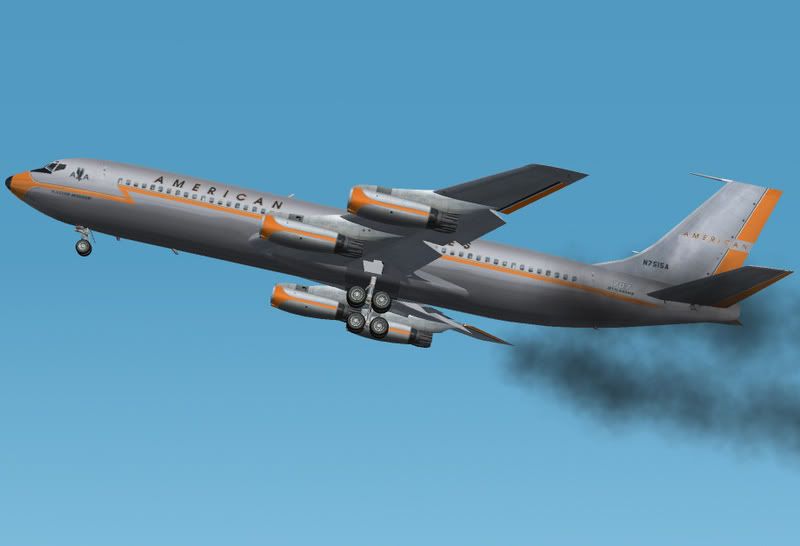
The first civil version of Boeing's new jet design was designated 707-7. This aircraft ultimately became B707-120 intended for domestic/transcontinental services. The USAF initially attempted claiming exclusive rights to the basic design, effectively preventing marketing of a civil aircraft version until this situation was resolved in Boeing's favor on July 13 1955. The very first civil order, for 20 B707-120's, was confirmed by Pan American World Airways on October 17 1955 ...the same day the airline, much to Boeing's irritation, also contracted for 25 DC8's. B707-120 first flew on December 20 l957 and was awarded FAA certification on September 18 1958. Deliveries to Pan American commenced from August 15 1958. On October 26 1958 the new jetliner entered service on Pan American's prestigeous New York/Paris route ...though beaten into service by some 22 days when BOAC commenced the worlds first ever scheduled trans-Atlantic jetliner service from October 4 1958 using COMET 4's along its London/New York route. The first US domestic B707 service was operated by National Airlines on December 10 1958 with an aircraft leased from Pan American. American Airlines, Continental Airlines, and TWA all soon acquired B707-120's and placed these aircraft into revenue service on domestic routes across the USA. Early production B707's featured short tails and lacked a lower rear fuselage ventral fin. The wing of B707-120 also initially featured double slotted trailing edge flaps only. Later production aircraft were equipped with 2 segments of leading edge Kruger Flap located between both inboard and outboard engines. 56 of these original B707 airframes were produced by Boeing. All B707-120's had a fuselage length of 144ft 6in with a cross-section diameter of 148in (this became the standard fuselage diameter of all production 707 models), wingspan of 130ft 10in, capacity for 110-174 PAX (depending on aircraft/airline configuration), and were powered by 4 P&W JT3C-6 turbojet engines (with water methanol injection system) rated at 11,200-13,500lb/st e/a and equipped with thrust reveresers. These aircraft had a MTOW of 247,000lb, and range of some 2,670nm depending upon payload/reserves. Only 8 of the 20 B707-120's first ordered by Pan American were ever delivered. The airline later ammended its contract in favour of larger more powerful B707-320's. Most B707-120's were upgraded with advanced aerodynamic and technical features during the early 1960's.
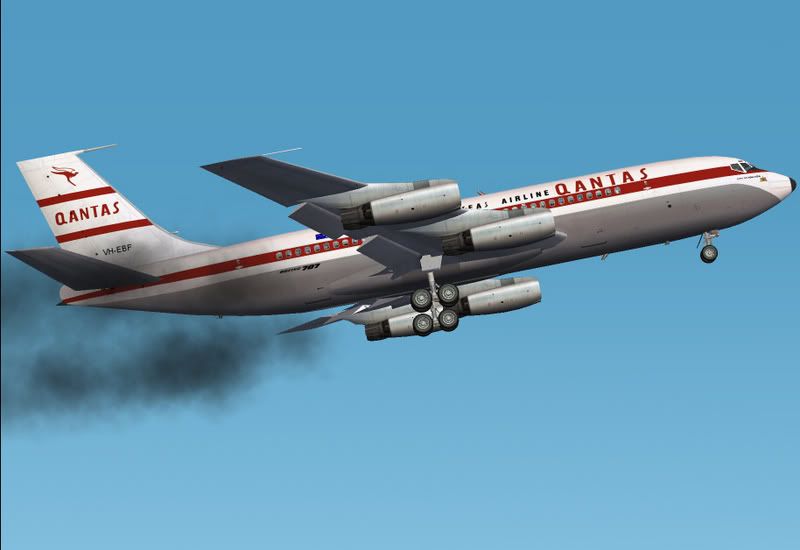
After lengthy evaluation of B707, COMET, & DC8 aircraft to assess which jetliner would best succeed its SUPER CONSTELLATION fleet, Australia's QANTAS Airways selected a unique B707 version designated B707-138. This aircraft first flew on March 20 1959 and was awarded FAA certification on June 7 1959. It was essentially a B707-120 airframe shortened by 10ft to promote additional range for a slight payload disadvantage to service the airlines long trans-Pacific route to San Francisco and Vancouver (via both Pago Pago and Honolulu). The COMET 4 was too small and lacked range, and Douglas was inflexible regarding modifications to its basic DC8 specification. By comparason it was Boeing's willingness to tailor B707 to airline preferences early in production that clinched the QANTAS contract and contributed significantly to success of the aircraft during later years. A total of only 13 B707-138 airframes were produced by Boeing. All were delivered to QANTAS. The airlines first 7 aircraft (delivered between July and September 1959) featured the same structural, aerodynamic, and powerplant specifications of B707-120. All B707-138's had a fuselage length of 134ft 6in, wingpan of 130ft 10 in, and capacity for 90-120 PAX depending on aircraft configuration. These aircraft were powered by 4 P&W JT3C-6 turbojet engines (with water methanol injection system) rated at 11,200-13,500lb/st e/a, and had a MTOW of 237,000lb, and range of some 3,500nm depending upon payload/reserves. The unique B707-138 series became shortest of the B707 family and first of the line approved for 5th pod operation. All 7 original QANTAS B707-138's were upgraded with advanced aerodynamic and technical features during the early 1960's whilst retaining their original wingtip lighting configuration and nose gear doors.
Original B707-120's (like COMET 4) were not entirely suitable for transatlantic operations. Being payload/fuel restricted these early jetliners could not fly non-stop between New York, Paris, or London without an en-route refuelling stop at either Gandar, Keflavik, or Shannon ...except in favourable conditions. Need for more capable aircraft (motivated by DC8-30 competition) prompted development of the intercontinental B707 series of greater power, operating weights, capacity, and range ...marketed as the B707-320 & B707-420. Both versions were structually identical and certified for similar performance differing principally in their respective powerplants.
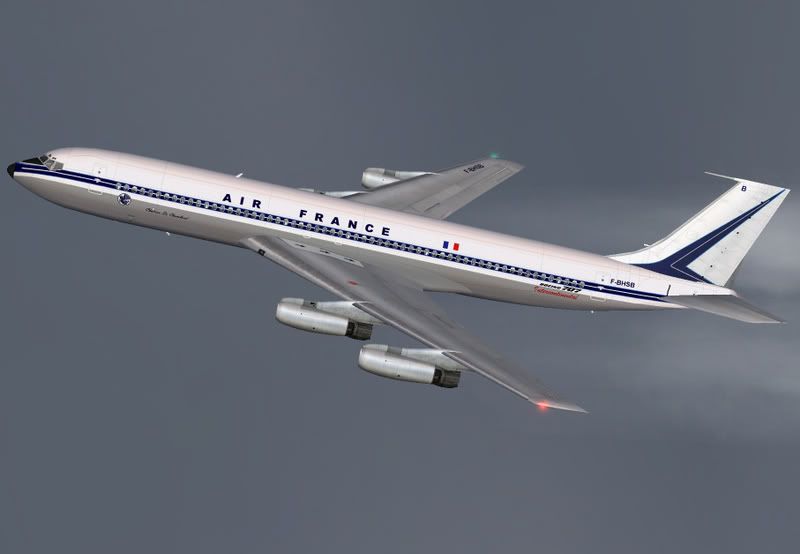
The B707-320 introduced an 8ft 5in fuselage stretch, horizontal stabilizers of 6ft greater span, main wings of 11ft 7in greater span and equipped with half span leading edge Kruger flaps, split trailing edge fillet flaps, and double slotted flaps to increase lift and reduce stalling speeds. Wing area was also slightly increased by reducing trailing edge sweep between inboard engines and the fuselage. This promoted 38% greater fuel capacity and increased range. B707-320 also established higher performance P&W JT4 series turbojet engines with the B707 line and became first of the intercontinental series aircraft. B707-320 first flew on January 11 l959 and was awarded FAA certification on July 15 1959. Deliveries commenced to Pan American from August 20 1959.
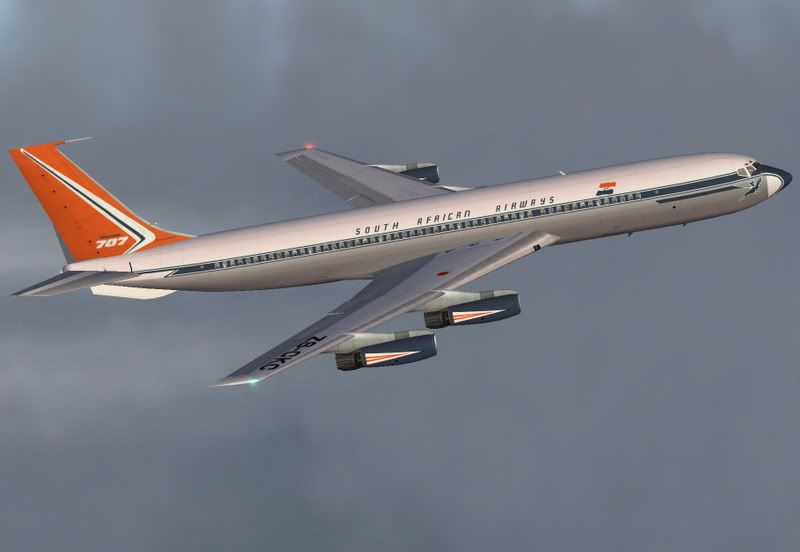
Early production B707-320's featured the short B707-120 tail and were not equipped with a lower rear fuselage ventral fin (as first delivered to Air France, Pan Am, and SABENA). B707-320's produced from mid 1960 were all built to advanced standards featuring both a tail extention, ventral fin, and other technical improvements. A total of 69 B707-320 airframes were produced by Boeing. None were ever upgraded to P&W fanjet power.
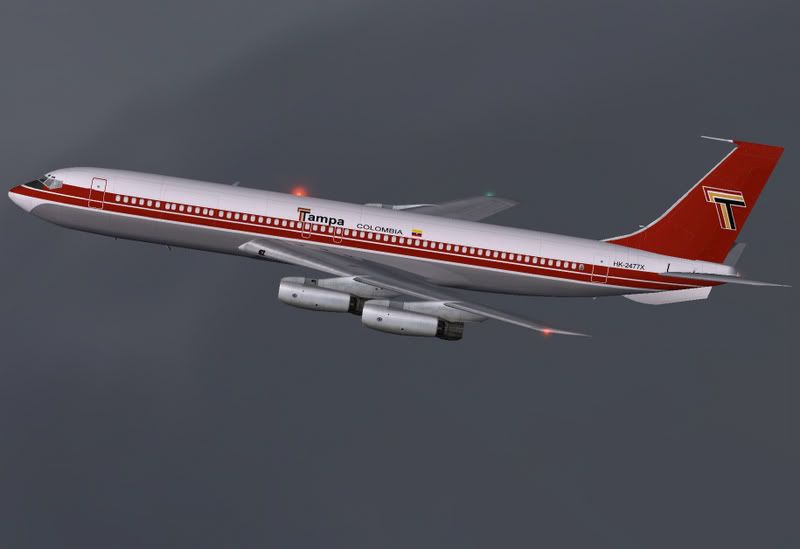
A few B707-320's were converted to pure frieghters later during their service careers ...redesignated B707-320F such as rare examples operated by Donaldson Cargo, and TAMPA Colombia during the 1970's and 80's. All B707-320's had a fuselage length of 152ft 11in (which became the standard fuselage length of all subsequent interncontinental models), wingspan of 142ft 5in, and capacity for 121-189 PAX depending on aircraft/airline configuration. These aircraft were powered by either P&W JT4A-3, JT4A-9, or JT4A-11 turbojet engines (depending upon airline selection) rated at between 16,800-17,500lb/st e/a, and had a MTOW of 234,000lb, and range of some 3,300nm depending on payload and reserves.
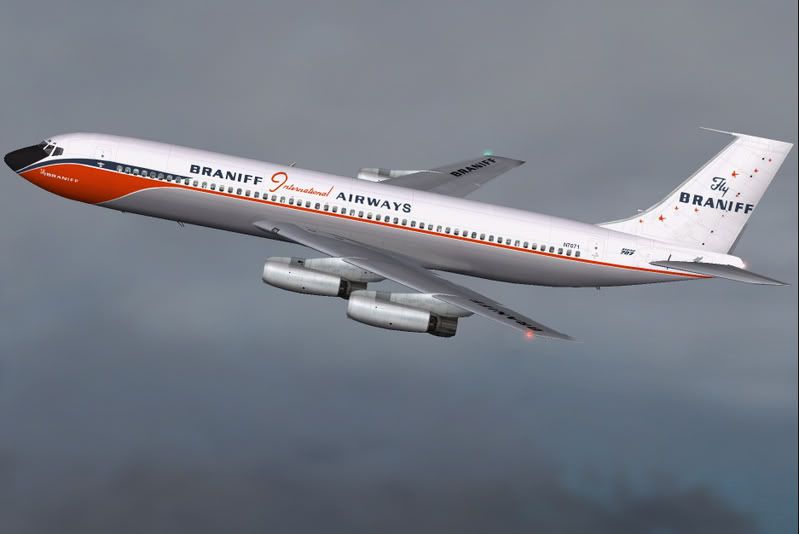
Early DC8-20 & -30 aircraft were more capable than B707-120. This saw a slight reduction in the B707/DC8 sales gap during the late 1950's and prompted Boeing to respond with another unique B707 model marketed as B707-220. Originally conceived as a shorter and narrower fuselage aircraft this version evolved into a lower MTOW B707-120. It retained the -120's wing and flap system but equipped with more powerful P&W JT4 turbojet engines promoting improved airfield performance, faster climb rate, and was ideally suited to hot and high operations. B707-220 first flew on May 11 1959 and was awarded FAA certification on November 5 1959. Deliveries commenced to Braniff International Airways from December 3 1959.

All B707-220 aircraft were constructed with the classic short tail and lacked a lower rear fuselage ventral fin. All were upgraded with tall extensions, ventral fin, 3 segments of leading edge Kruger flap, and other advanced technical features during the early 1960's. Only 5 B707-220 airframes were ever produced by Boeing. All were delivered to Braniff and operated the airlines international routes routes between the USA and Latin American destinations until 1971. Some of these aircraft later saw service with BWIA. All had been withdrawn from service by the early 1980's. None were ever upgraded to fanjet power. All B707-220's had a fuselage length of 144ft 2in, wingspan of 130ft 10in, and capacity for 121-189 PAX depending on aircraft/airline configuration. These aircraft were powered by 4 P&W JT4A-3 turbojet engines rated at 15,800lb/st e/a, and had a MTOW of 257,000 lbs, and range of some 4,100nm depending upon payload and reserves. The last remaining example of this rare B707 version was scrapped during l984.

The RR CONWAY fanjet powered B707-420 became 2nd of the intercontinental series B707's. This aircraft first flew on May 19 l959 and was awarded FAA certification on February 12 1960. Deliveries commenced to Air India from February 21 1960. Early production B707-420's also featured the short B707-120 tail and were not equipped with a lower rear fuselage ventral fin (as first delivered to both Air India, and Lufthansa). To obtain British certification a 3ft 7in tail extension and a ventral fin (the size of which differed slightly between models) were developed to improve aircraft lateral stability during assymetric circumstances. This directive was the result of a fatal accident occurring to a Braniff B707-220 acceptance flight on October 19 1959. These modifications were subsequently applied to all B707's produced from mid 1960 and retrofitted to most earlier production aircraft. B707-420 earned the distinction of becomming first of the B707 line to feature such aerodynamic enhancements, powered rudder, and fanjet type engines of improved fuel economy. British CAA appoval for B707-420 was awarded on April 27 1960. Deliveries to BOAC began from April 28 1960 with services commencing during May 1960. A total of 37 B707-420 airframes were produced by Boeing.

All B707-420's had a fuselage length of 152ft 11in, wingspan of 142ft 5in, and capacity for 121-189 PAX depending upon aircraft/airline configuration. These aircraft were powered by RR CONWAY 508 fanjet engines rated at 17,500lb/st e/a, and had a MTOW of 312,000lb, and range of some 3,980nm depending on payload and reserves. RR CONWAY powered B707-420 aircraft were mostly operated by airlines of countries under British political/economic influence.
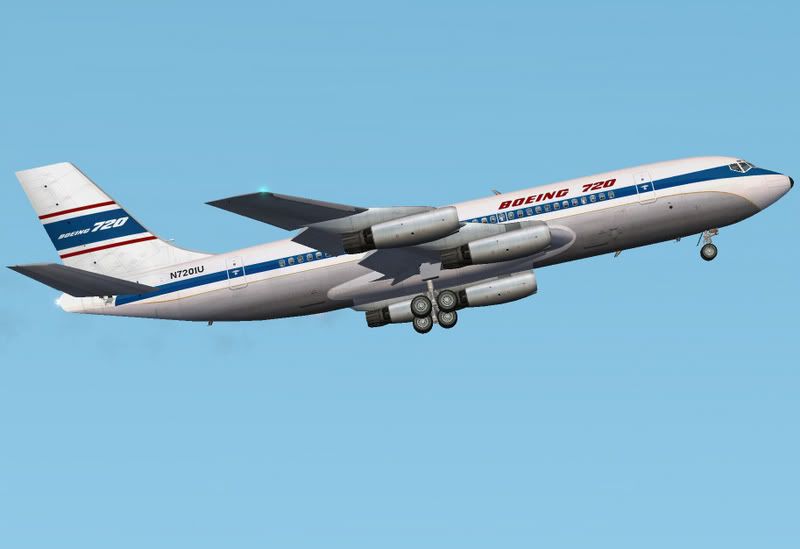
The late 1950's were a boomtime for Boeing establishing its new B707 jetliner on world markets despite significant competition from the DC8. Boeing also percieved General Dynamics luxury high-speed CV880 to be a threat which prompted it to revamp the basic B707-120 design. This resulted in the technically simpler B720-020 ...a low cost, reduced MTOW, short/meduim range jetliner 8ft 4in shorter than B707-120. This aircraft also introduced a revised wing design, equipped with wing leading edge/glove extensions between the fuselage and both inboard engines, and full span leading edge flaps. These modifications promoted improved airfield and cruise speed performances. B720-020 first flew on November 23 1959 and was awarded FAA certification on June 30 1960.
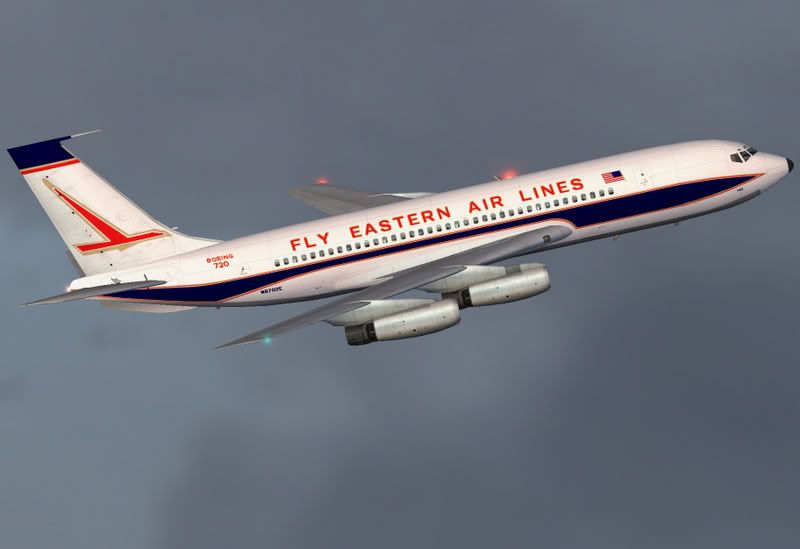
The first 3 B720's produced featured the classic short tail and no lower rear fuselage ventral fin but were modified prior completion of the aircrafts certification program. Tail extensions and ventral fin enhancements were incorporated into the B720 design and applied to all production aircraft. Deliveries to United Airlines commenced from April 30 1960. A total 69 B720-020 airframes were produced by Boeing.
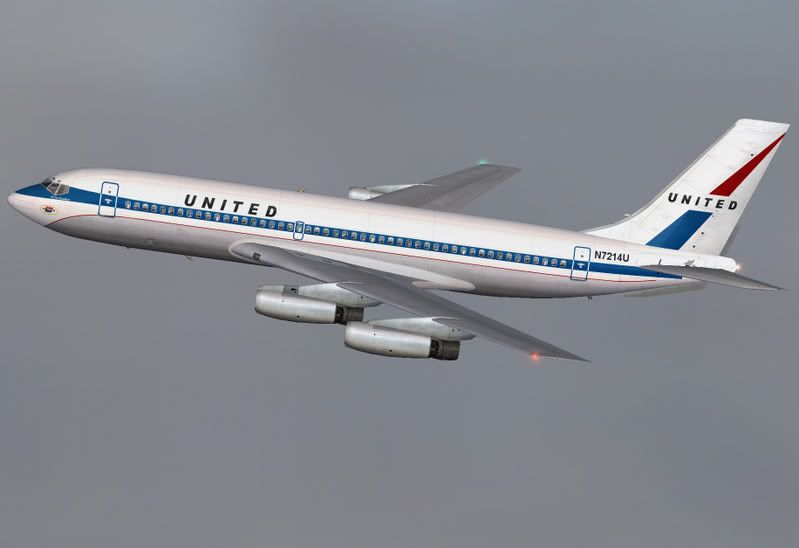
United B720's differed from most. Operated on short/medium haul domestic routes these aircraft were not equipped with long range over water navigation equipment and lacked the classic B707 tail probe/VHF antenae.
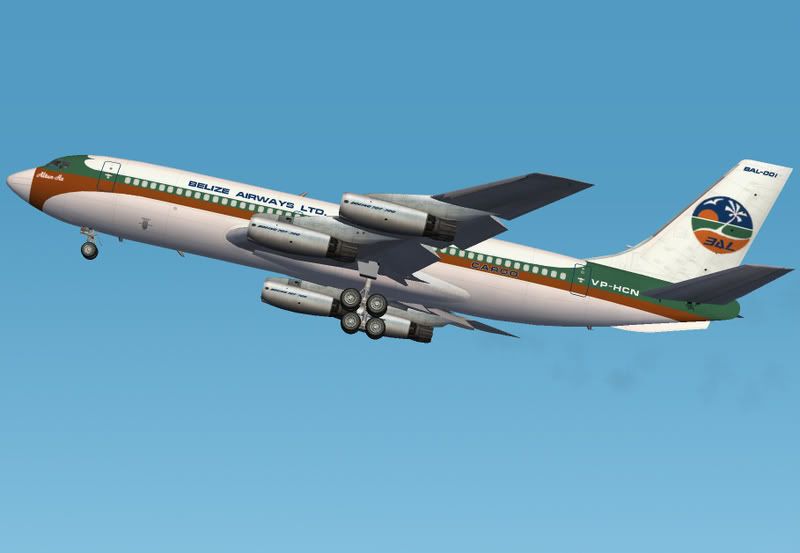
At least 1 B720-020 was operated as a pure freighter by Belize Airways Cargo during the late 1970's but lacked a forward fuselage maindeck cargo door. All B720-020's had a fuselage length of 139ft 9in, wingspan of 130ft 10in, and capacity for 112-149 PAX depending on aircraft/airline configuration. These aircraft were powered by 4 derated P&W JT3C-7 turbojet engines rated at 12,000lb/st e/a, and had a MTOW 229,000lb, and range of some 2,120 nm depending upon payload and reserves.
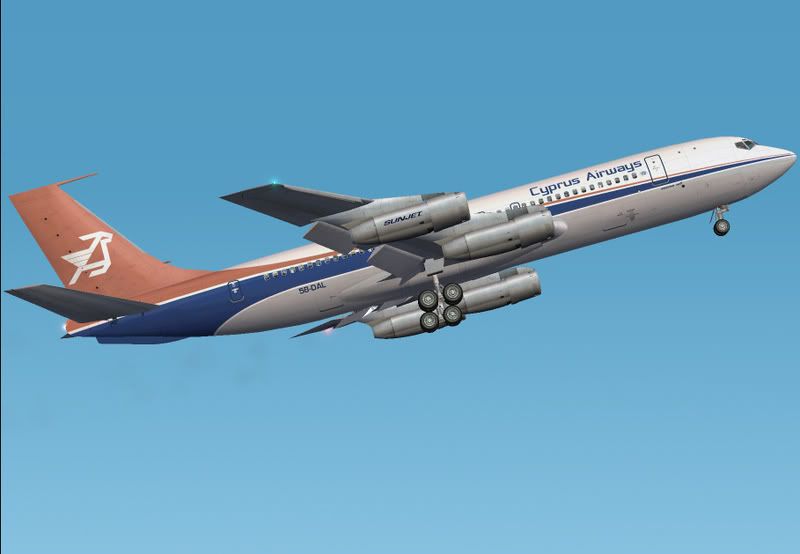
Aerodynamic and technical modifications applied to B707's during the early 1960's resulted in most early production B707-120's being upgraded to B707-120B standard. This version was also marketed as a new production model during the late 1950's. Modifications included tail extensions, addition of a lower rear fuselage ventral fin, powered rudder, wing leading edge/glove extensions, full span leading edge flaps (first applied to B720-020), horizontal stabilizers of 1ft 8in greater span, and P&W JT3D series fanjet engines of greater power, fuel economy, and environmental acceptability. Early P&W fanjets featured small sucker doors located near the center of the inlet casing to increase air-flow through each engine. In comparason with older turbojets these engines produced some 30% more thrust for almost equal savings in fuel burn. This promoted improvemmts in both aircraft performance and range though MTOW remained unchanged from the standard B707-120 model. Late production aircraft also featured a modified wingtip lighting configuration and redesigned nose gear doors. B707-120B first flew on June 22 1960 and was awarded FAA certification on March 1 1961. Deliveries of new-build aircraft commenced to American Airlines from May 1961. Only American Airlines, Continental Airlines, and TWA ordered factory fresh B707-120B's which accounted for some 72 of the total 128 B707-120/B series aircraft built by Boeing
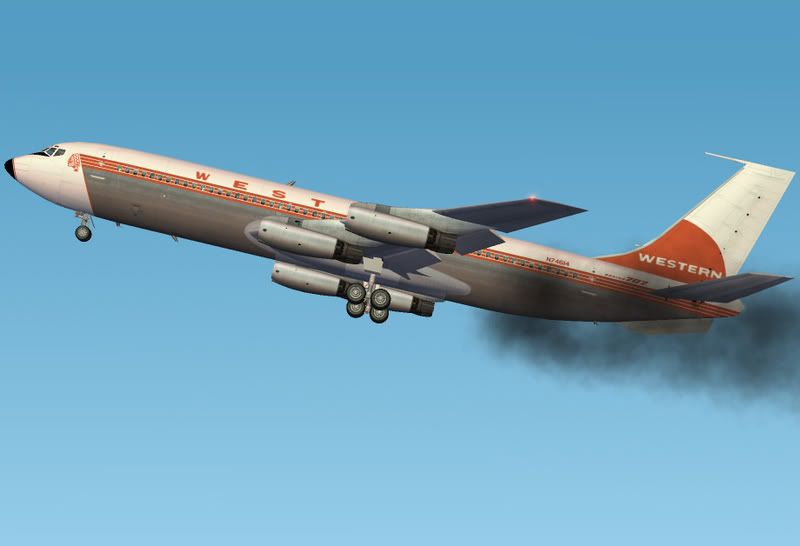
A small number of original B707-120 aircraft were only progressively upgraded. These aircraft recieved tail extensions, ventral fin, and other standard technical enhancements immediately but retained their original turbojet engines prior to later re-enginning with P&W fanjets.
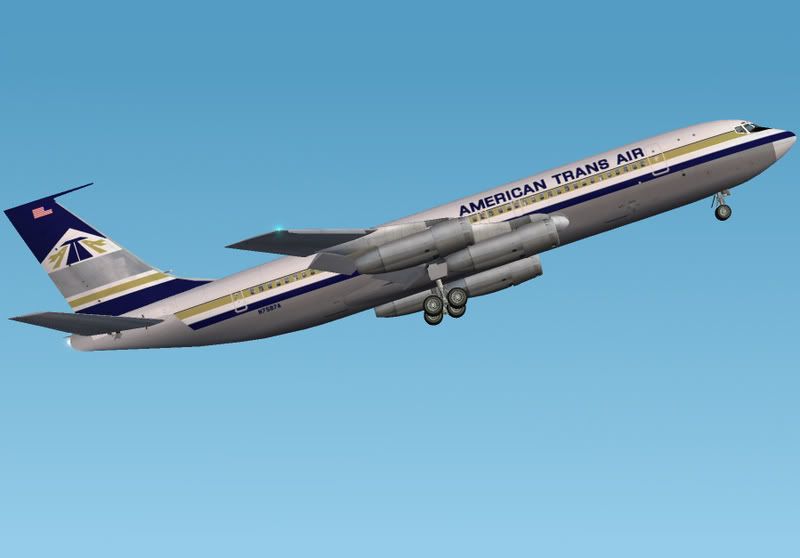
Other aircraft were upgraded with tail extensions, fanjet engines, and other standard technical enhancements but lacked the ventral fin or had this particular feature removed later during their service careers.
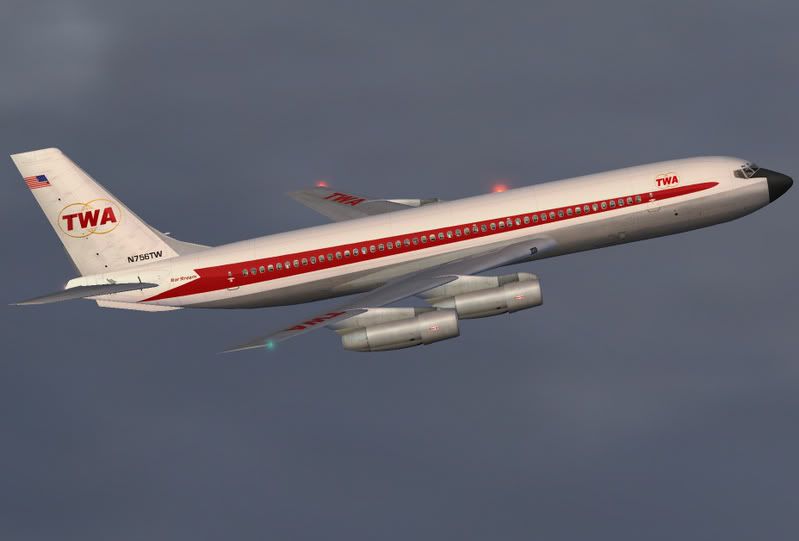
Some short haul/domestic B707-120B's did not feature the classic B707 tail probe/VHF antenae ...such as a small number of the TWA fleet.
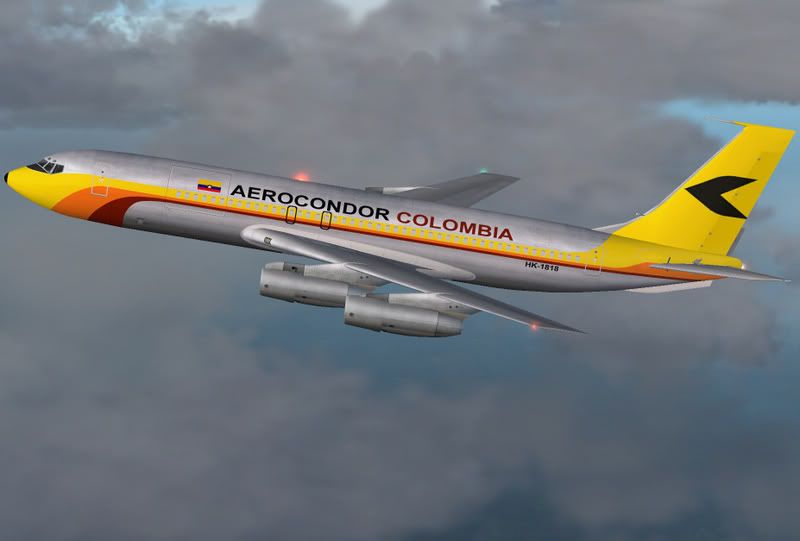
At least 1 B707-120B was converted to a pure freighter and operated by Aeroconder de Colombia during the late 1970's ...redesignated B707-120BF and equipped with a forward fuselage port side maindeck cargo door. All B707-120B's had a fuselage length of 144ft 6in, wingspan of 130ft 10in, and capacity for 110-174 PAX depending on aircraft/airline configuration. These aircraft were powered by 4 P&W JT3D-1 or P&W JT3D-3 fanjet engines (depending upon airline selection) rated at 17,000-18,000lb/st e/a respectively, and had a MTOW of 257,000lb, and range of some 3,680nm depending upon payload/reserves.
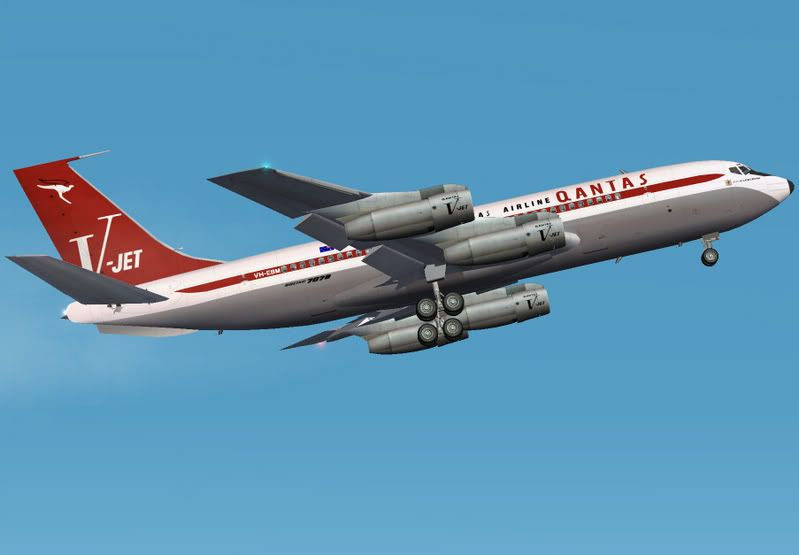
QANTAS Airways last 6 B707-138 series aircraft (delivered between July 1961 and September 1964) were all built to B707-120B standard ...designated B707-138B. These aircraft featured the same aerodynamic and technical modifications applied to B707-120B (even further enhancing this already high performing aircraft and earning it the industry accolade "Hot Rod"), a later type wingtip lighting configuration, and redesigned nose gear doors. FAA certification for B707-138B was awarded on July 24 1961. The original 7 QANTAS B707-138's were all upgraded to B707-138B's between September 1961 and January 1962. These aircraft served QANTAS until 1968 being replaced with larger more powerful B707-320C's. Beyond their Australian service the unique B707-138B's were operated by Bahamas World Airways, Boraq Indonesian Airways, Braniff International, British Eagle Airways, BWIA, Canadian Pacific Airways, El Al, Government of Saudia Arabia, Laker Airways, Merpati Nusantara Airlines, Montana Flugdeinst, Pacific Western Airlines, and Turkish Airlines. Some of these aircraft were upgraded with Stage 2 Hush Kits during the 1980's and converted to VIP transports operated by corporate enterprises and charter companies. At least 1 aircraft remains in service today (N707JT "Jett Clipper Ella") and privately owned by celebrety John TRAVOLTA. Another ex QANTAS B707-138B (the original VH-EBA from 1959) was recently reactivated from long term storage at Stanstead and flown to Australia for preservation by the QANTAS Foundation Memorial Museum ...re-registered VH-XBA it supports the airlines original 1959 livery. All B707-138B aircraft had a fuselage length of 134ft 6in, wingpan of 130ft 10 in, and capacity for 90-120 PAX depending on aircraft/airline configuration. These aircraft were powered by 4 P&W JT3D-1 fanjet engines rated at 17,000lb/st e/a, and had a MTOW of 257,000lbs, and range of some 4,900nm depending upon payload/reserves.
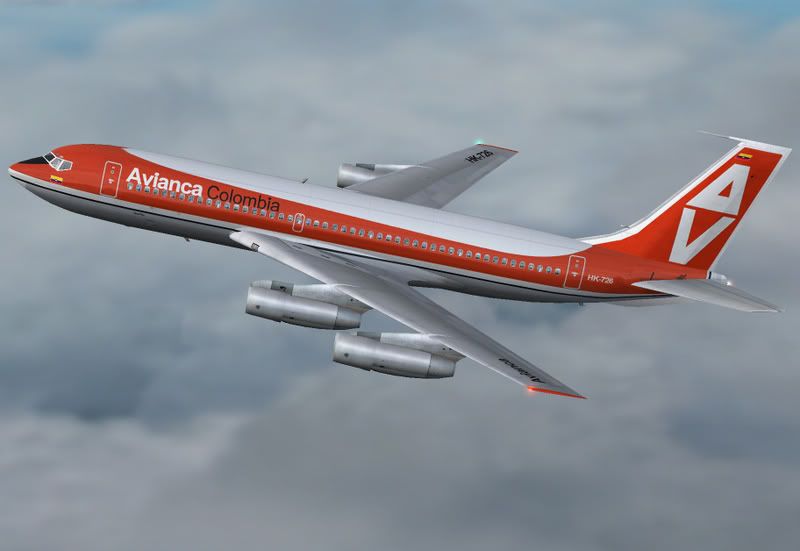
B720-020 was closely followed by development of the more powerful B720-020B. This version represented a logical mating of the standard B720 airframe and P&W JT3D fanjet engines which resulted in an aircraft of even greater performance, economy, and better able to challenge CV990. B720-020B first flew on October 6 1960 and was awarded FAA certification on March 3 1961. Deliveries commenced to American Airlines from Februry 3 1961. Many turbojet powered B720's were upgraded to B720-B standard during the early 1960's ...including the entire American Airlines fleet. Regarded throughout the airline industry as a bargain basement jetliner, the cheaper and slower B720 was more economic than either CV880 or CV990 even in derated turbojet form and became instrumental in destroying any potential market success for the Convair jetliners. B720-B also demonstrated by far the best airfield performance of the entire B707 line. A total of 89 B720-020B airframes were produced by Boeing.
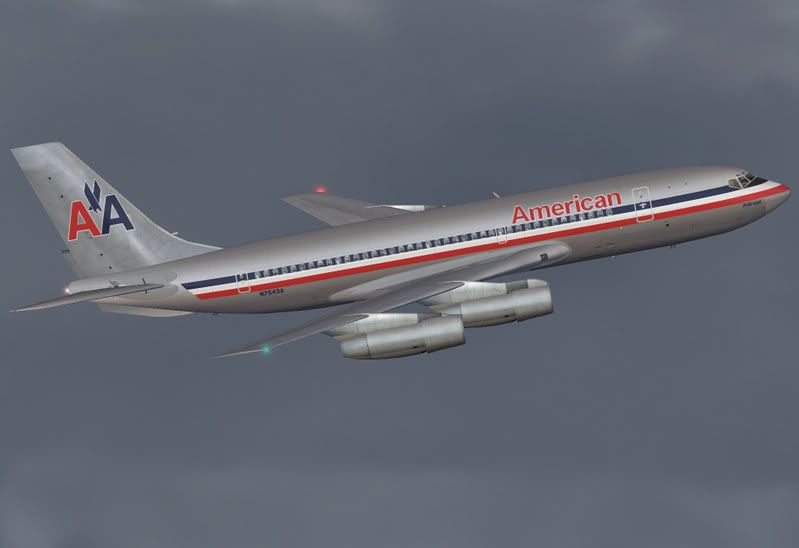
Short haul/domestic configured B720-B's did not feature the classic B707 tail probe/VHF antenae ...such as aircraft operated by American Airlines.
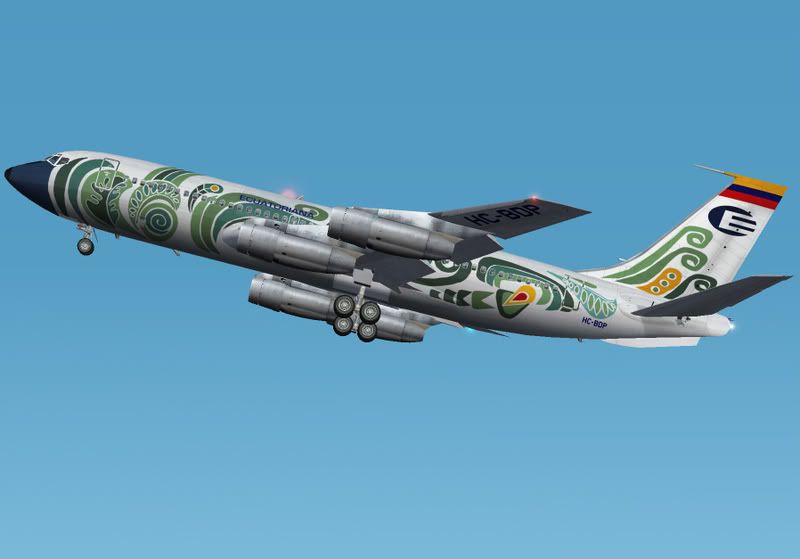
At least 1 B720B was converted to a pure freighter and operated by Ecuatoriana Cargo during the late 1970's ...redesignated B720-020BF and equipped with a forward fuselage port side maindeck cargo door. All B720-020B's had a fuselage length of 139ft 9in, wingspan of 130ft 10in, and capacity for 112-149 PAX depending on aircraft/airline configuration. These aircraft were powered by 4 P&W JT3D-1 fanjet engines rated at 17,000lb/st e/a, and had a MTOW of 234,000lb, and range of some 3,300nm depending on payload and reserves.
Throughout early years of the Boeing/Douglas battle for jetliner supremacy the sales gap between both B707 & DC8 remained somewhat marginal. Developing B367-80 had been an expensive gamble for Boeing ...made even more costly by numerous market and performance oriented enhancements incorporated into B707/720 design throughout production but which also eventually contributed to Boeing's ultimate triumph.
See EVOLUTION OF A LEGEND - B707 FAMILY (part 2)
Mark CRANSTON
AKL/NZ
B367-80 (otherwise known as DASH 80) is the aircraft which spawned the B707 legend. Intended as a jet tanker/transporter demonstrator, work on this new design began during 1952 under a preliminary 707-6 title and publicly announced as B367-80 during September 1952. This designation was intended to misslead Boeing's competitors into believing the new aircraft was little more than another military project and a jet powered successor to Boeing's piston engined KC97 tanker then in service with the USAF rather than a prospective commercial transport. Fully funded by Boeing to the tune of some $16 milion (1952) dollars, it was hoped this expenditure would be reclaimed through Independant Research & Development funding followed by long term production of both military and civil contracts. It was also anticipated construction of both variants would utilize the same tooling but through market pressure, and progressive design enhancement, 2 distinctly different families of aircraft emerged with little in common with each other despite visually similar external silhouettes. B367-80 was completed some 2 weeks ahead of schedule and rolled-out at Boeing/Renton on March 14 l954 christianed "Jet Stratoliner". On July 15 1954 the new aircraft performed its maiden flight and the B707 legend was born.

B367-80 had a fuselage length of 127ft 10in with a cross-section diameter of 132in, and a wingspan of 130ft. At the time of its first flight the aircraft was powered by 4 P&W JT3P turbojet engines (with water methanol injection system) rated at 9,500-11,000lb/st e/a and not equipped with thrust reversers. The aircraft had a MTOW of 190,000lb, and payload range of some 2,600nm.
Throughout its long service career B367-80 was used extensively by Boeing for both demonstration and development work in support of C135, B707, B727, and other aircraft programes, scientific research in conjunction with NASA, and systems analysis in association with the Seattle Flight Test Center. These projects saw the aircraft constantly modified over the years with various combinations of powerplants, alterations to both wing and flap systems, experimental landing gear, and various other projections. By 1971 B367-80 had outlived its usefulness as a research/development platform and was withdrawn from service. It was donated to the National Air & Space Museum/Smithsonian Institution on November 26 1972 and stored at Davis-Monthan AFB Arizona for some 18 years. Resurrected from the desert on May 7 1990, B367-80 was returned to its Seattle birthplace for refurbishment and display at the Boeing Museum of Flight as one of the single most important aircraft of the jet age.
Early B367-80 demostration flights soon convinced the USAF of the new aircrafts potential. This resulted in a huge military contract for production of an aircraft Boeing termed B717 but which was redesignated C135 (type) on the USAF inventory. The first military production aircraft was a KC135-A named "City of Renton". This aircraft was rolled-out at Boeing/Renton on July 18 1956 and first flew on August 31 1956. It was delivered to USAF/SAC at Castle AFB California on June 28 1957. Production of USAF C135 aircraft amassed to some 820 airframes over a wide range of derivatives fulfilling numerous specialist air roles across a multitude of military/government service descriptions.

KC135-A aircraft had a fuselage length of 136ft 2in with a cross-section diameter of 144in, wingspan of 130ft 10in, and were powered by 4 P&W J57-P-59W turbojet engines (with water methanol injection system) rated at 11,200-13,000lb/st e/a and not equipped with thrust reversers. These aircraft had a MTOW of up to 300,000lbs (overload) though typically this was reduced to 112,400-261,000lbs, and range of some 1,880nm depending upon payload and reserves. Despite their logistic/strategic versatility KC135-A aircraft were among the most noisy, dirty, and airfield demanding aircraft on the USAF inventory requiring no less than 10,000-13,700ft of runway depending upon load circumstances.

The first civil version of Boeing's new jet design was designated 707-7. This aircraft ultimately became B707-120 intended for domestic/transcontinental services. The USAF initially attempted claiming exclusive rights to the basic design, effectively preventing marketing of a civil aircraft version until this situation was resolved in Boeing's favor on July 13 1955. The very first civil order, for 20 B707-120's, was confirmed by Pan American World Airways on October 17 1955 ...the same day the airline, much to Boeing's irritation, also contracted for 25 DC8's. B707-120 first flew on December 20 l957 and was awarded FAA certification on September 18 1958. Deliveries to Pan American commenced from August 15 1958. On October 26 1958 the new jetliner entered service on Pan American's prestigeous New York/Paris route ...though beaten into service by some 22 days when BOAC commenced the worlds first ever scheduled trans-Atlantic jetliner service from October 4 1958 using COMET 4's along its London/New York route. The first US domestic B707 service was operated by National Airlines on December 10 1958 with an aircraft leased from Pan American. American Airlines, Continental Airlines, and TWA all soon acquired B707-120's and placed these aircraft into revenue service on domestic routes across the USA. Early production B707's featured short tails and lacked a lower rear fuselage ventral fin. The wing of B707-120 also initially featured double slotted trailing edge flaps only. Later production aircraft were equipped with 2 segments of leading edge Kruger Flap located between both inboard and outboard engines. 56 of these original B707 airframes were produced by Boeing. All B707-120's had a fuselage length of 144ft 6in with a cross-section diameter of 148in (this became the standard fuselage diameter of all production 707 models), wingspan of 130ft 10in, capacity for 110-174 PAX (depending on aircraft/airline configuration), and were powered by 4 P&W JT3C-6 turbojet engines (with water methanol injection system) rated at 11,200-13,500lb/st e/a and equipped with thrust reveresers. These aircraft had a MTOW of 247,000lb, and range of some 2,670nm depending upon payload/reserves. Only 8 of the 20 B707-120's first ordered by Pan American were ever delivered. The airline later ammended its contract in favour of larger more powerful B707-320's. Most B707-120's were upgraded with advanced aerodynamic and technical features during the early 1960's.

After lengthy evaluation of B707, COMET, & DC8 aircraft to assess which jetliner would best succeed its SUPER CONSTELLATION fleet, Australia's QANTAS Airways selected a unique B707 version designated B707-138. This aircraft first flew on March 20 1959 and was awarded FAA certification on June 7 1959. It was essentially a B707-120 airframe shortened by 10ft to promote additional range for a slight payload disadvantage to service the airlines long trans-Pacific route to San Francisco and Vancouver (via both Pago Pago and Honolulu). The COMET 4 was too small and lacked range, and Douglas was inflexible regarding modifications to its basic DC8 specification. By comparason it was Boeing's willingness to tailor B707 to airline preferences early in production that clinched the QANTAS contract and contributed significantly to success of the aircraft during later years. A total of only 13 B707-138 airframes were produced by Boeing. All were delivered to QANTAS. The airlines first 7 aircraft (delivered between July and September 1959) featured the same structural, aerodynamic, and powerplant specifications of B707-120. All B707-138's had a fuselage length of 134ft 6in, wingpan of 130ft 10 in, and capacity for 90-120 PAX depending on aircraft configuration. These aircraft were powered by 4 P&W JT3C-6 turbojet engines (with water methanol injection system) rated at 11,200-13,500lb/st e/a, and had a MTOW of 237,000lb, and range of some 3,500nm depending upon payload/reserves. The unique B707-138 series became shortest of the B707 family and first of the line approved for 5th pod operation. All 7 original QANTAS B707-138's were upgraded with advanced aerodynamic and technical features during the early 1960's whilst retaining their original wingtip lighting configuration and nose gear doors.
Original B707-120's (like COMET 4) were not entirely suitable for transatlantic operations. Being payload/fuel restricted these early jetliners could not fly non-stop between New York, Paris, or London without an en-route refuelling stop at either Gandar, Keflavik, or Shannon ...except in favourable conditions. Need for more capable aircraft (motivated by DC8-30 competition) prompted development of the intercontinental B707 series of greater power, operating weights, capacity, and range ...marketed as the B707-320 & B707-420. Both versions were structually identical and certified for similar performance differing principally in their respective powerplants.

The B707-320 introduced an 8ft 5in fuselage stretch, horizontal stabilizers of 6ft greater span, main wings of 11ft 7in greater span and equipped with half span leading edge Kruger flaps, split trailing edge fillet flaps, and double slotted flaps to increase lift and reduce stalling speeds. Wing area was also slightly increased by reducing trailing edge sweep between inboard engines and the fuselage. This promoted 38% greater fuel capacity and increased range. B707-320 also established higher performance P&W JT4 series turbojet engines with the B707 line and became first of the intercontinental series aircraft. B707-320 first flew on January 11 l959 and was awarded FAA certification on July 15 1959. Deliveries commenced to Pan American from August 20 1959.

Early production B707-320's featured the short B707-120 tail and were not equipped with a lower rear fuselage ventral fin (as first delivered to Air France, Pan Am, and SABENA). B707-320's produced from mid 1960 were all built to advanced standards featuring both a tail extention, ventral fin, and other technical improvements. A total of 69 B707-320 airframes were produced by Boeing. None were ever upgraded to P&W fanjet power.

A few B707-320's were converted to pure frieghters later during their service careers ...redesignated B707-320F such as rare examples operated by Donaldson Cargo, and TAMPA Colombia during the 1970's and 80's. All B707-320's had a fuselage length of 152ft 11in (which became the standard fuselage length of all subsequent interncontinental models), wingspan of 142ft 5in, and capacity for 121-189 PAX depending on aircraft/airline configuration. These aircraft were powered by either P&W JT4A-3, JT4A-9, or JT4A-11 turbojet engines (depending upon airline selection) rated at between 16,800-17,500lb/st e/a, and had a MTOW of 234,000lb, and range of some 3,300nm depending on payload and reserves.

Early DC8-20 & -30 aircraft were more capable than B707-120. This saw a slight reduction in the B707/DC8 sales gap during the late 1950's and prompted Boeing to respond with another unique B707 model marketed as B707-220. Originally conceived as a shorter and narrower fuselage aircraft this version evolved into a lower MTOW B707-120. It retained the -120's wing and flap system but equipped with more powerful P&W JT4 turbojet engines promoting improved airfield performance, faster climb rate, and was ideally suited to hot and high operations. B707-220 first flew on May 11 1959 and was awarded FAA certification on November 5 1959. Deliveries commenced to Braniff International Airways from December 3 1959.

All B707-220 aircraft were constructed with the classic short tail and lacked a lower rear fuselage ventral fin. All were upgraded with tall extensions, ventral fin, 3 segments of leading edge Kruger flap, and other advanced technical features during the early 1960's. Only 5 B707-220 airframes were ever produced by Boeing. All were delivered to Braniff and operated the airlines international routes routes between the USA and Latin American destinations until 1971. Some of these aircraft later saw service with BWIA. All had been withdrawn from service by the early 1980's. None were ever upgraded to fanjet power. All B707-220's had a fuselage length of 144ft 2in, wingspan of 130ft 10in, and capacity for 121-189 PAX depending on aircraft/airline configuration. These aircraft were powered by 4 P&W JT4A-3 turbojet engines rated at 15,800lb/st e/a, and had a MTOW of 257,000 lbs, and range of some 4,100nm depending upon payload and reserves. The last remaining example of this rare B707 version was scrapped during l984.

The RR CONWAY fanjet powered B707-420 became 2nd of the intercontinental series B707's. This aircraft first flew on May 19 l959 and was awarded FAA certification on February 12 1960. Deliveries commenced to Air India from February 21 1960. Early production B707-420's also featured the short B707-120 tail and were not equipped with a lower rear fuselage ventral fin (as first delivered to both Air India, and Lufthansa). To obtain British certification a 3ft 7in tail extension and a ventral fin (the size of which differed slightly between models) were developed to improve aircraft lateral stability during assymetric circumstances. This directive was the result of a fatal accident occurring to a Braniff B707-220 acceptance flight on October 19 1959. These modifications were subsequently applied to all B707's produced from mid 1960 and retrofitted to most earlier production aircraft. B707-420 earned the distinction of becomming first of the B707 line to feature such aerodynamic enhancements, powered rudder, and fanjet type engines of improved fuel economy. British CAA appoval for B707-420 was awarded on April 27 1960. Deliveries to BOAC began from April 28 1960 with services commencing during May 1960. A total of 37 B707-420 airframes were produced by Boeing.

All B707-420's had a fuselage length of 152ft 11in, wingspan of 142ft 5in, and capacity for 121-189 PAX depending upon aircraft/airline configuration. These aircraft were powered by RR CONWAY 508 fanjet engines rated at 17,500lb/st e/a, and had a MTOW of 312,000lb, and range of some 3,980nm depending on payload and reserves. RR CONWAY powered B707-420 aircraft were mostly operated by airlines of countries under British political/economic influence.

The late 1950's were a boomtime for Boeing establishing its new B707 jetliner on world markets despite significant competition from the DC8. Boeing also percieved General Dynamics luxury high-speed CV880 to be a threat which prompted it to revamp the basic B707-120 design. This resulted in the technically simpler B720-020 ...a low cost, reduced MTOW, short/meduim range jetliner 8ft 4in shorter than B707-120. This aircraft also introduced a revised wing design, equipped with wing leading edge/glove extensions between the fuselage and both inboard engines, and full span leading edge flaps. These modifications promoted improved airfield and cruise speed performances. B720-020 first flew on November 23 1959 and was awarded FAA certification on June 30 1960.

The first 3 B720's produced featured the classic short tail and no lower rear fuselage ventral fin but were modified prior completion of the aircrafts certification program. Tail extensions and ventral fin enhancements were incorporated into the B720 design and applied to all production aircraft. Deliveries to United Airlines commenced from April 30 1960. A total 69 B720-020 airframes were produced by Boeing.

United B720's differed from most. Operated on short/medium haul domestic routes these aircraft were not equipped with long range over water navigation equipment and lacked the classic B707 tail probe/VHF antenae.

At least 1 B720-020 was operated as a pure freighter by Belize Airways Cargo during the late 1970's but lacked a forward fuselage maindeck cargo door. All B720-020's had a fuselage length of 139ft 9in, wingspan of 130ft 10in, and capacity for 112-149 PAX depending on aircraft/airline configuration. These aircraft were powered by 4 derated P&W JT3C-7 turbojet engines rated at 12,000lb/st e/a, and had a MTOW 229,000lb, and range of some 2,120 nm depending upon payload and reserves.

Aerodynamic and technical modifications applied to B707's during the early 1960's resulted in most early production B707-120's being upgraded to B707-120B standard. This version was also marketed as a new production model during the late 1950's. Modifications included tail extensions, addition of a lower rear fuselage ventral fin, powered rudder, wing leading edge/glove extensions, full span leading edge flaps (first applied to B720-020), horizontal stabilizers of 1ft 8in greater span, and P&W JT3D series fanjet engines of greater power, fuel economy, and environmental acceptability. Early P&W fanjets featured small sucker doors located near the center of the inlet casing to increase air-flow through each engine. In comparason with older turbojets these engines produced some 30% more thrust for almost equal savings in fuel burn. This promoted improvemmts in both aircraft performance and range though MTOW remained unchanged from the standard B707-120 model. Late production aircraft also featured a modified wingtip lighting configuration and redesigned nose gear doors. B707-120B first flew on June 22 1960 and was awarded FAA certification on March 1 1961. Deliveries of new-build aircraft commenced to American Airlines from May 1961. Only American Airlines, Continental Airlines, and TWA ordered factory fresh B707-120B's which accounted for some 72 of the total 128 B707-120/B series aircraft built by Boeing

A small number of original B707-120 aircraft were only progressively upgraded. These aircraft recieved tail extensions, ventral fin, and other standard technical enhancements immediately but retained their original turbojet engines prior to later re-enginning with P&W fanjets.

Other aircraft were upgraded with tail extensions, fanjet engines, and other standard technical enhancements but lacked the ventral fin or had this particular feature removed later during their service careers.

Some short haul/domestic B707-120B's did not feature the classic B707 tail probe/VHF antenae ...such as a small number of the TWA fleet.

At least 1 B707-120B was converted to a pure freighter and operated by Aeroconder de Colombia during the late 1970's ...redesignated B707-120BF and equipped with a forward fuselage port side maindeck cargo door. All B707-120B's had a fuselage length of 144ft 6in, wingspan of 130ft 10in, and capacity for 110-174 PAX depending on aircraft/airline configuration. These aircraft were powered by 4 P&W JT3D-1 or P&W JT3D-3 fanjet engines (depending upon airline selection) rated at 17,000-18,000lb/st e/a respectively, and had a MTOW of 257,000lb, and range of some 3,680nm depending upon payload/reserves.

QANTAS Airways last 6 B707-138 series aircraft (delivered between July 1961 and September 1964) were all built to B707-120B standard ...designated B707-138B. These aircraft featured the same aerodynamic and technical modifications applied to B707-120B (even further enhancing this already high performing aircraft and earning it the industry accolade "Hot Rod"), a later type wingtip lighting configuration, and redesigned nose gear doors. FAA certification for B707-138B was awarded on July 24 1961. The original 7 QANTAS B707-138's were all upgraded to B707-138B's between September 1961 and January 1962. These aircraft served QANTAS until 1968 being replaced with larger more powerful B707-320C's. Beyond their Australian service the unique B707-138B's were operated by Bahamas World Airways, Boraq Indonesian Airways, Braniff International, British Eagle Airways, BWIA, Canadian Pacific Airways, El Al, Government of Saudia Arabia, Laker Airways, Merpati Nusantara Airlines, Montana Flugdeinst, Pacific Western Airlines, and Turkish Airlines. Some of these aircraft were upgraded with Stage 2 Hush Kits during the 1980's and converted to VIP transports operated by corporate enterprises and charter companies. At least 1 aircraft remains in service today (N707JT "Jett Clipper Ella") and privately owned by celebrety John TRAVOLTA. Another ex QANTAS B707-138B (the original VH-EBA from 1959) was recently reactivated from long term storage at Stanstead and flown to Australia for preservation by the QANTAS Foundation Memorial Museum ...re-registered VH-XBA it supports the airlines original 1959 livery. All B707-138B aircraft had a fuselage length of 134ft 6in, wingpan of 130ft 10 in, and capacity for 90-120 PAX depending on aircraft/airline configuration. These aircraft were powered by 4 P&W JT3D-1 fanjet engines rated at 17,000lb/st e/a, and had a MTOW of 257,000lbs, and range of some 4,900nm depending upon payload/reserves.

B720-020 was closely followed by development of the more powerful B720-020B. This version represented a logical mating of the standard B720 airframe and P&W JT3D fanjet engines which resulted in an aircraft of even greater performance, economy, and better able to challenge CV990. B720-020B first flew on October 6 1960 and was awarded FAA certification on March 3 1961. Deliveries commenced to American Airlines from Februry 3 1961. Many turbojet powered B720's were upgraded to B720-B standard during the early 1960's ...including the entire American Airlines fleet. Regarded throughout the airline industry as a bargain basement jetliner, the cheaper and slower B720 was more economic than either CV880 or CV990 even in derated turbojet form and became instrumental in destroying any potential market success for the Convair jetliners. B720-B also demonstrated by far the best airfield performance of the entire B707 line. A total of 89 B720-020B airframes were produced by Boeing.

Short haul/domestic configured B720-B's did not feature the classic B707 tail probe/VHF antenae ...such as aircraft operated by American Airlines.

At least 1 B720B was converted to a pure freighter and operated by Ecuatoriana Cargo during the late 1970's ...redesignated B720-020BF and equipped with a forward fuselage port side maindeck cargo door. All B720-020B's had a fuselage length of 139ft 9in, wingspan of 130ft 10in, and capacity for 112-149 PAX depending on aircraft/airline configuration. These aircraft were powered by 4 P&W JT3D-1 fanjet engines rated at 17,000lb/st e/a, and had a MTOW of 234,000lb, and range of some 3,300nm depending on payload and reserves.
Throughout early years of the Boeing/Douglas battle for jetliner supremacy the sales gap between both B707 & DC8 remained somewhat marginal. Developing B367-80 had been an expensive gamble for Boeing ...made even more costly by numerous market and performance oriented enhancements incorporated into B707/720 design throughout production but which also eventually contributed to Boeing's ultimate triumph.
See EVOLUTION OF A LEGEND - B707 FAMILY (part 2)
Mark CRANSTON
AKL/NZ




